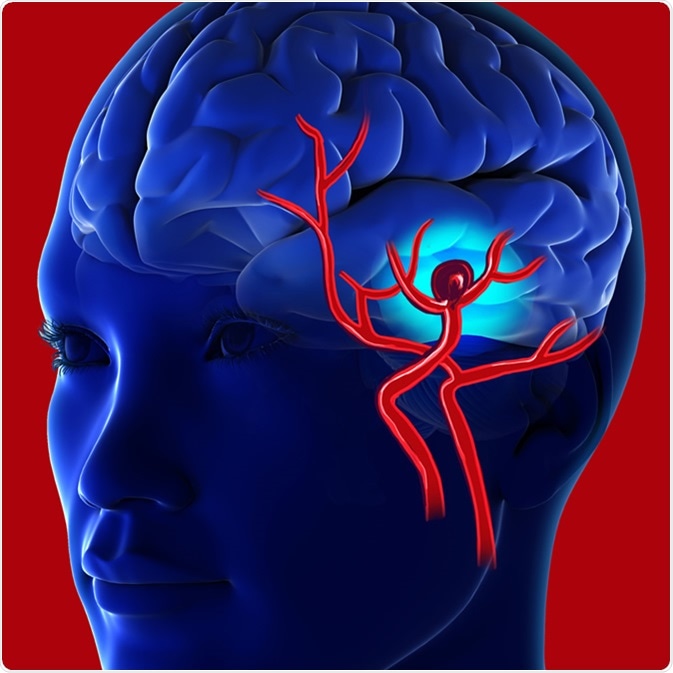Skip to:
What are Aneurysms?
Aneurysms are characterized as a weak or thin spot within one of the blood vessels’ walls that subsequently fills with blood creating a bulge.
Aneurysms can develop in multiple places within the body. However, they are most commonly reported in the aorta and the brain. In brain aneurysms, the affected walls are typically weakened following injury, disease, or due to a congenital abnormality.
The majority of aneurysms remain unnoticeable until they rupture. The rupture of an aneurysm in the brain can lead to the onset of a subarachnoid hemorrhage – characterized as bleeding in the area between the brain and the skull.

Cerebral aneurysm illustration. Image Credit: Romanova Natali / Shutterstock
Such bleeding can result in brain damage and potentially some of the following symptoms:
- Nausea and emesis
- Stiffness of the neck
- The sudden onset of an excruciating headache
- Light sensitivity
- Temporary loss of consciousness
Subarachnoid hemorrhages can result in the onset of hydrocephalus, whereby cerebrospinal fluid develops in the skull resulting in swelling and increasing the pressure on the brain. Further health complications of ruptures can also occur as a result of rupturing, including long-lasting nerve damage, stroke, and, ultimately, death.
Treating Aneurysms using Cancer Drugs
In light of the complications that can occur if aneurysms rupture, researchers continue to investigate potential treatment options to reduce the likelihood of such occurrences.
Typically, treatment for aneurysms can be difficult and involve the patient undergoing complex surgery in a proportion of high-risk cases. However, new research has found that the use of a class of drug used to treat cancer may be a safer and effective alternative.
The team used a technologically advanced DNA sequencing to identify a new genetic basis for a specific type of brain aneurysm. They found that a mutation in the PDGFRB gene, previously associated with human developmental disorders, was linked to the development of some brain aneurysms.
Further analysis found that mutations in the gene result in an abnormality in the protein it encodes for. This specific abnormality is considered to cause the protein to remain locked in hyper-active form, known as ‘gain-of-function variants’, meaning the protein is permanently ‘turned-on.’
The researchers also found the effects of the abnormally functioning protein can, in some instances, be counteracted by a class of receptor tyrosine kinase inhibitors used to treat certain forms of cancer.
Implications of the Research
Although only a preliminary investigation, the effects found can be applied to make changes in public healthcare and treatments.
Although the research initially aimed to understand the cellular and genetic mechanism of a specific type of aneurysm, such understandings of the genetics of disease may be useful when creating new treatments.
The researchers are also working on completing further testing, which may lead to drug repurposing, which has been seen in other famous cases, such as the use of thalidomide to treat myeloma and leprosy.
Alternative Treatments for Aneurysms
In most cases, treatment for aneurysms is only offered if the probability of rupturing is high as the majority of aneurysms do not rupture and remain intact. Treatment may be recommended depending on the location of the aneurysm, its size, the patient’s age, the presence of comorbid health conditions, and family medical history.
The two main treatment procedures typically offered are endovascular coiling and neurosurgical clipping.
The procedures both aim to prevent the likelihood of a rupture by reducing the blood flow to the site of the aneurysm. Neurosurgical clipping is an operation whereby the surgeon uses a metal clip to seal off the aneurysm.
Following the procedure, the blood vessel lining will begin to heal over the clip, permanently sealing it off. Those undergoing endovascular coiling will have a tube guided from their groin or leg to the site of the brain aneurysm where metal coils are deposited directly into the aneurysm.
Once full of the platinum coils, the aneurysm is unable to receive blood supply. In patients that pose a low risk of rupture, regular appointments to monitor the aneurysm are often recommended.
Last Updated: Mar 16, 2020